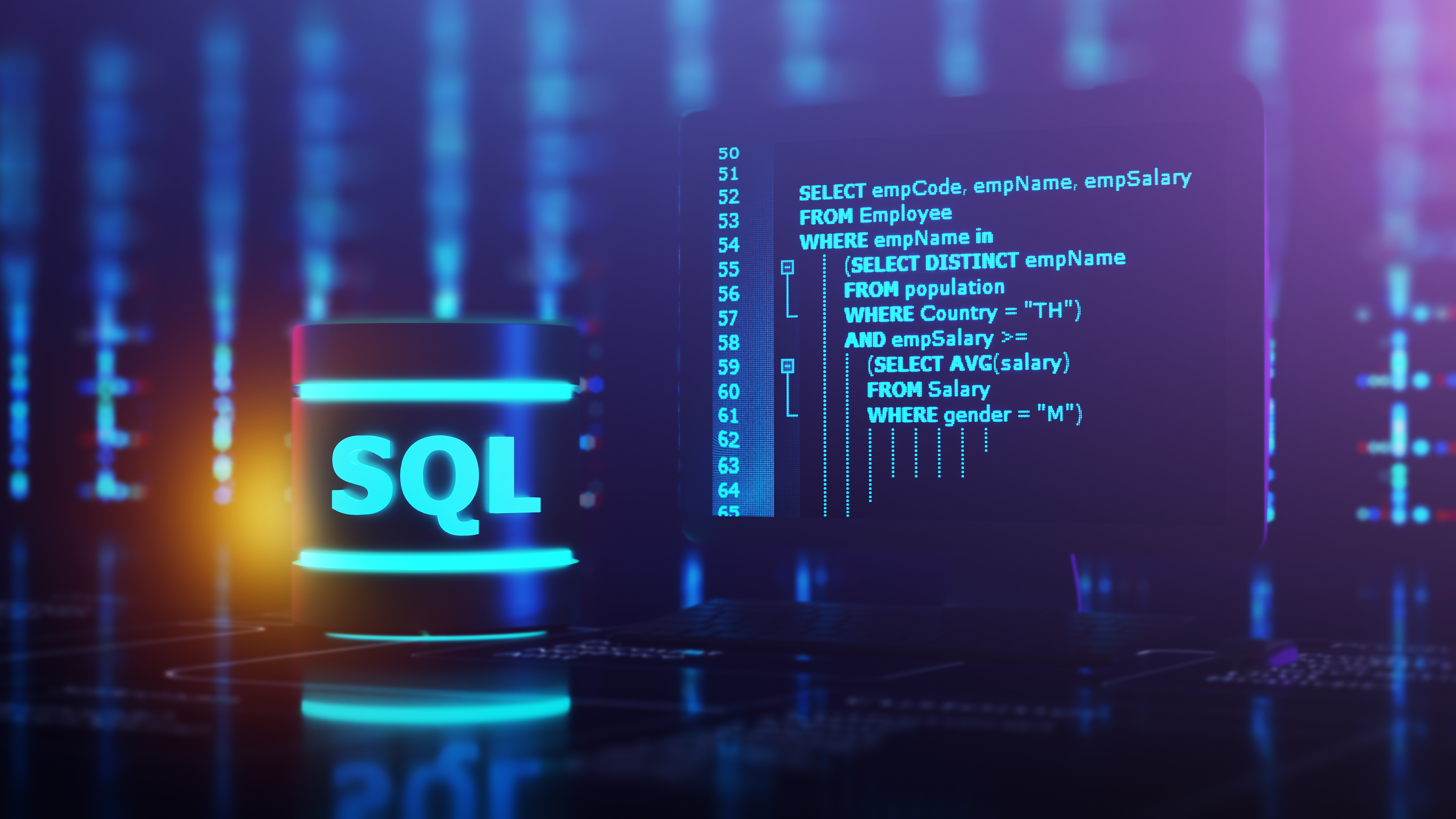From the latest smart watches and voice assistants like Amazon Echo or Google Nest, to e-commerce platforms and enterprise software, the digital tools we use every day, in both our personal and professional lives, are generating data on a near constant basis. And with the Internet of Things (IoT) and digital transformation becoming the norm, even our most ordinary interactions have become torrents of structured information.
So it’s no wonder that data has become the engine that drives modern decision-making across every industry imaginable. But, if the soul level insights that power platforms like TikTok and Spotify are what you’re after, then you need some way to harness that data. To interact with it in a language it understands.
And that language is Structured Query Language (SQL).
SQL was invented in the ‘70s and even all these decades later, it’s the standard for retrieving, manipulating, and structuring the data in relational databases with precision. In fact, SQL is among the top five programming, scripting, and markup languages popular in enterprise environments today, with 51% of professional developers using it regularly.
But what exactly is SQL, and why does it matter to you?

How Does SQL Work?
SQL is a programming language you use to interact with a database — and get only the information you actually want from it when you do. So what it’s doing, essentially, is helping you talk to relational databases: systems that store data in neatly organised tables made up of rows (records) and columns (attributes).
Databases are relational when the tables within them have shared data points, meaning you can link those tables to each other because the info in one is related to the info in another.
This is all possible because SQL uses something called schemas. You can think of these as the blueprint or architectural layout of your database. So they’re telling you what tables you’ll find in your database, how each table relates to all the others, and what kind of data lives in each column of those tables.
When you want to extract specific information from your database, you use what is known as queries. Whether you’re trying to generate a report on your sales from the last quarter, or create a dashboard for monitoring the user activity related to a specific product line — a query is the question that lets you extract, filter, and manipulate only the relevant data you need or want.
There are four basic functions that SQL operates on: Create, Read, Update, and Delete — or CRUD as it’s commonly referred to. Just about every SQL based data interaction is built on the foundation of these actions. So let’s say you want to get a list of all your South African customers. Your query would probably look something like this:
SELECT * FROM customers WHERE country = 'South Africa';
Your question, in plain English, is: “Show me all the records from the customers table where the data in the country column is South Africa.”
The simplicity of SQL means that whether you’re working with a few dozen records or millions — the intuitiveness, flexibility, and scalability of SQL stays the same.

What is a data language?
A data language is exactly what it sounds like — any programming, scripting, and markup language that you can use to interact with data. This could mean anything from defining how it’s structured to retrieving or updating it
There are dozens of data languages out there, but SQL is one of the most used, and probably the most well known of them all. A key characteristic of SQL is that it’s a declarative data language. So all you have to say is, “get me that data based on these conditions,” and the database engine figures it out from there.
If you were using an imperative programming language, like Python or Java, to query a database, you’d not only have to say what you want, but also give step by step instructions on where to find the info, how to extract it, and how to present it to you.
It’s the simplicity of its declarative nature that makes SQL so powerful: it speaks the language of data, clearly, and efficiently.
What is SQL used for?
It should be obvious by now that SQL sits at the heart of how businesses interact with their data. But it’s not something only professional developers and your IT department are using, either. Instead, it’s used to power everything from performance dashboards and customer segmentation reports to internal analytics and automated workflows.
If your team is tracking KPIs, forecasting trends, or measuring campaign results, SQL is likely the tool being used to turn all that raw data into insights you can actually use.
SQL plays an equally critical role on the backend side of programming though. It’s how your applications store, retrieve, and manage structured data — whether that’s user accounts, product inventory, financial records, or content libraries.
So it’s fundamental to web development, application logic, and data warehousing, and underpins everything from e-commerce platforms to SaaS products and enterprise systems. In short, it’s one of the most versatile tools in the modern tech stack.
It’s also essential in automation. In Extract, Transform, Load (ETL) processes, you’re moving data across systems, cleaning it, reshaping it, and prepping it for analysis. These kinds of operational flows depend on SQL to keep your data flows cleanly between your operational tools, analytics engines, and business applications and make sure that it arrives clean, complete, and in the right format.
That said, SQL isn’t the only option when it comes to managing data. In use cases where your data is unstructured, rapidly changing, or distributed across multiple systems, NoSQL databases offer a lot more flexibility. While SQL enforces strict schemas and table relationships, NoSQL trades this structure for speed and scale — so it’s ideal for dynamic environments with evolving data models.
Why is SQL Important?
Part of what makes SQL so important is just how universal it is. You’ll find it everywhere — across every department, in every industry, on every platform that deals with structured data. Whether you’re working in finance, healthcare, logistics, retail, or marketing, SQL is still the language doing the heavy lifting behind reporting, analytics, and data access.
It’s also what makes structured data accessible. SQL doesn’t just store information — it gives you the power to standardise how that information is defined, linked, retrieved, and used. So even if your business is dealing with multiple datasets across different systems, SQL makes it possible to turn all of that into something usable.
Something you can turn into actionable insights.
And it’s not just legacy systems keeping SQL alive. Instead it’s evolved right alongside modern data needs, with the latest version — SQL:2023 — introducing support for graph queries and improved JSON functions. This makes it more compatible with today’s data environments, which tend to follow hybrid and semi-structured models.
Another important update is that it’s designed to integrate with modern Business Information (BI) tools, data lakes, and cloud platforms. So it can serve as the bridge that your data teams use to link structured storage with advanced analytics.
What Are SQL Components?
SQL is made up of different sets of commands — or components — each designed to handle a specific aspect of how you interact with a database. Think of them like toolkits. Each one has its own function, but together they cover the full lifecycle of working with data: from creating a database structure to inserting records, setting access permissions, and making sure changes are properly saved or rolled back when needed.
Here’s a quick breakdown of the core components:
- Data Definition Language (DDL)
- This is how you define or modify the structure of your database.
- Commands include CREATE, ALTER, and DROP.
- If you’re creating a new table for customer data, you’d use DDL to define its columns and data types.
- Data Manipulation Language (DML)
- These are the commands you use to work with the actual data inside your tables.
- Examples include SELECT, INSERT, UPDATE, and DELETE.
- Whether you're pulling a monthly sales report or updating a customer address, you’re using ML.
- Data Control Language (DCL)
- DCL is about access. It lets you manage who can see or edit what.
- Key commands are GRANT and REVOKE.
- So if you want to give a marketing analyst read-only access to a dataset — this is how you do it.
- Transaction Control Language (TCL)
- TCL ensures your changes happen reliably and in the right order.
- Commands like COMMIT and ROLLBACK let you confirm or undo actions.
- For example, if part of an update fails, you can roll everything back to maintain data integrity.
Each of these components plays a specific role — but together, they’re what make SQL a complete and reliable way to manage structured data.
How to Learn SQL
One of the best things about SQL is that it’s surprisingly easy to get started with — even if you don’t come from a traditional programming background. Whether you're a marketer trying to get more from campaign data, or a product manager that wants to improve how you report on user behaviour, SQL is a skill that opens doors across roles and industries.
If you're starting from scratch, there are plenty of beginner-friendly resources to choose from.
Platforms like W3Schools, Codecademy, and Coursera offer interactive tutorials and step-by-step courses designed to walk you through the fundamentals. Most of these let you practice directly in your browser, so there’s no setup required.
Once you’ve got the basics down pat, the best way to build confidence is by experimenting. Work with sample databases like AdventureWorks or Sakila to explore real-world schemas and queries. Use SQL sandboxes or open-source tools like DB Fiddle or SQLite to write and test queries in a safe environment. The more you play with the data, the more intuitive SQL starts to feel.
It’s also a skill that tends to show up across job descriptions — not just in technical roles. Analysts, marketers, product teams, operations leads — even founders — all benefit from knowing how to pull and shape data without waiting on someone else to do it for them. Being able to write your own queries doesn’t just make you more efficient — it gives you direct access to insights, and that’s often where the real leverage lies.

Commonly Used SQL Commands
There are dozens of SQL commands, but most day-to-day work is built on a core set. These are the ones you’ll come across most often — whether you’re pulling a quick report, combining data from multiple tables, or inserting new records into a database.
Here’s a quick guide to the most commonly used SQL commands and what they do:
| Command | Purpose | Example |
| SELECT | Pulls data from a table | SELECT * FROM customers; |
| FROM | Specifies the table you’re working with | SELECT * FROM customers; |
| WHERE | Filters results based on specific conditions | SELECT * FROM orders WHERE status = 'shipped'; |
| JOIN | Combines rows from two or more tables based on a related column | SELECT orders.id, customers.name FROM orders JOIN customers ON orders.customer_id = customers.id; |
| GROUP BY | Groups rows that have the same values in specified columns | SELECT COUNT(*) FROM orders GROUP BY customer_id; |
| ORDER BY | Sorts the result set in ascending or descending order | SELECT * FROM products ORDER BY price DESC; |
| INSERT | Adds new data to a table | INSERT INTO customers (name, email) VALUES ('Alice Smith', 'alice@email.com'); |
These commands are the building blocks of most SQL queries. Learn how they work together, and you’ll be able to write queries that do exactly what you need — no matter the size or complexity of your dataset.
Using SQL to Future-Proof Businesses
Structured Query Language (SQL) isn’t just a foundational skill — it’s a future-proof one. As businesses continue to generate and rely on structured data across cloud platforms, analytics tools, and enterprise systems, SQL remains the connective thread that makes that data useful. Whether you’re analysing trends, building reports, or powering entire applications, SQL gives you the control and clarity to do it all — in a language that’s built to last.







Comments ( 0 )